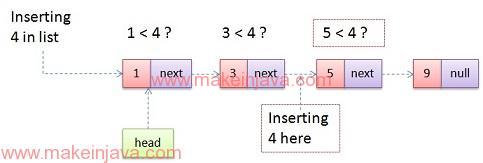- Given a sorted singly linked containing elements.
- Insert a new node to a single linked list such that linked list remains sorted.
- Iterate through the single linked list & find the appropriate place to insert a element.
- Linked list should remain sorted after insertion.
- Traverse the sorted singly linked list to insert new element using iterative (non recursive) algorithm.

Algorithm: insert element to a sorted singly linked list.
- Take backup of head node
- Suppose, we would like to insert a new node 4 in a linked list [shown in Fig 1]
- Start iterating the linked list from head node
- Compare first node with new node [element 4]
- 1 < 4 ? Its true, take the back of node 1.
- Compare second node with new node [element 4]
- 3 < 4 ? Its true, take the back of node 3.
- Compare third node with new node [element 4]
- 5 < 4 ? Its false, node should be inserted node 5
- Insert a node 4 before Node 5
- Rearrange the references, so that 4 inserted in linked list
- 5 < 4 ? Its false, node should be inserted node 5
- return the head node of linked list
- We have shown the above algorithm in Fig 2.
- Time complexity of algorithm is O (n).
- Compare first node with new node [element 4]

Similarly, we can apply above algorithm to insert new element 7 in a linked list. We have shown it in Fig 3.

- print function will print the linked list.
- insert function will insert a new node to a sorted linked list.
Program: insert node/ element to a sorted singly linked list in java
1.) InsertInSortedList class:
- InserInSortedList class is responsible for inserting new node to single linked list.
- We will traverse the single linked and find out the appropriate place, to insert new node in a linked list.
package org.learn.Question;public class InsertInSortedList { public static Node insert(Node head, Node newNode) { // first node to be inserted if (null == head) { return newNode; } Node prev = null; Node iter = head; while (iter != null && iter.data < newNode.data) { // take backup of prev node // used in appending the new node prev = iter; iter = iter.next; } newNode.next = prev.next; prev.next = newNode; return head; } public static void prepareList(Node head, int data) { while (head.next != null) head = head.next; head.next = new Node(data); } public static void print(Node head) { while (head != null) { System.out.printf("%d ", head.data); head = head.next; } System.out.println(""); }} |
2.) SingleLinkedListClient Class:
We are performing following operation in SingleLinkedListClient class
- We are creating the singlelinked list as shown in Fig 1.
- InsertInSortedList.insert method will insert a new node to sorted single linked list
- We are printing the final single linked list.
package org.learn.Client;import org.learn.Question.InsertInSortedList;import org.learn.Question.Node;public class SingleLinkedListClient { public static void main(String[] args) { int[] listData = { 1, 3, 5, 9 }; Node head = new Node(listData[0]); for (int count = 1; count < listData.length; count++) { InsertInSortedList.prepareList(head, listData[count]); } System.out.printf("1. Single linked list is : "); InsertInSortedList.print(head); int newData = 4; Node newNode = new Node(newData); head = InsertInSortedList.insert(head, newNode); System.out.printf("2. Single linked list after inserting %d is : ", newData); InsertInSortedList.print(head); newData = 7; newNode = new Node(newData); head = InsertInSortedList.insert(head, newNode); System.out.printf("3. Single linked list after inserting %d is : ", newData); InsertInSortedList.print(head); }} |
3.) Node Class:
- Node class representing the node(s) of single linked list
package org.learn.Question;public class Node { public int data; public Node next; public Node(int num) { this.data = num; this.next = null; }} |
Output: insert a node/element to a sorted singly linked list in java
1. Single linked list is : 1 3 5 9 2. Single linked list after inserting 4 is : 1 3 4 5 9 3. Single linked list after inserting 7 is : 1 3 4 5 7 9 |
